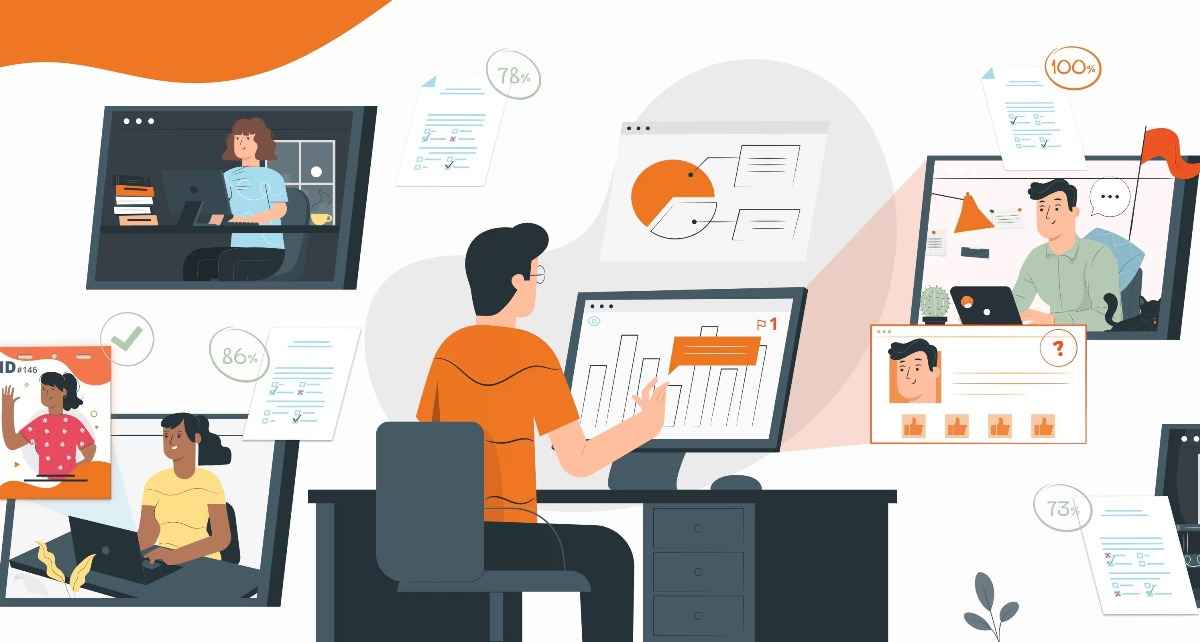
Proctoring is an age-old approach to controlling and guiding exams in educational institutions. Proctor exams are taken under constant supervision by trained specialists who provide support and catch cheaters.
Technological advancements made it possible for proctoring to evolve into a myriad of streamlined, automated varieties. It’s not the subject of this material, but there’s a lot more to learn about proctored examinations.
Table of Contents
A virtual online assessment is meant to evaluate the expertise, skills, and performance of pupils through digital technologies. It allows individuals to take tests and exams remotely, usually online, without the need for physical presence.
These assessments have become increasingly common in education and professional settings in the last decade.
Auto proctoring, for its part, is a tech-driven proctoring method that ensures the integrity of such assessments.
It’s short for automatic proctoring and typically employs software and AI solutions to supervise test-takers during virtual exams. Such procedures detect and prevent cheating, as well as other forms of dishonest behaviour.
The synergy between virtual online assessments and auto proctoring represents a dynamic partnership in the realm of remote evaluations.
Virtual online assessments provide the flexibility and accessibility needed for remote learning and testing while auto-proctoring bolsters the security and credibility of these assessments.
Together, they enable a seamless and trustworthy assessment process that meets the demands of modern education and professional certification. So, let’s explore the intricate workings of this symbiotic relationship to understand its significance in the digital age.
To begin, setting up the assessment environment is crucial. Test-takers access the virtual assessment platform, where they provide the necessary identification and establish their testing area.
This stage involves verifying the integrity of the test-taker’s surroundings by scanning their environment and ensuring compliance with assessment guidelines.
During the assessment, real-time monitoring and data collection are in effect. Auto proctoring software employs webcam, microphone, and screen capture to monitor test-takers.
Advanced algorithms detect suspicious behaviours, such as eye movement, background noise, or irregular screen activity, and notify proctors if intervention is required.
Simultaneously, data, including audiovisual feeds, are recorded for subsequent analysis. However, data collection must be conducted reasonably. Remote proctoring has already been in trouble for ‘violating privacy,’ as illuminated by Bloomberg.
Post-assessment analysis plays a crucial role in evaluating the integrity of the assessment. Proctors and automated systems review the recorded data to identify any irregularities or violations.
This phase involves examining flagged instances, checking for unauthorized resources, and ensuring the test’s fairness.
The analysis informs the final assessment results, confirming the legitimacy of the outcomes and maintaining the credibility of the evaluation process.
Virtual online assessments with auto proctoring offer enhanced security and integrity. Automated proctoring systems employ advanced algorithms to detect and deter cheating, ensuring that test-takers complete assessments honestly.
This increased security bolsters the credibility of online evaluations, preserving the value of certifications and educational outcomes.
The combination of virtual online assessments and auto proctoring enhances convenience and accessibility. Test-takers can participate in assessments from anywhere with an internet connection, eliminating the need for physical test centres or travel.
This accessibility accommodates diverse learners, including those with geographical constraints or physical disabilities, making education and certification more inclusive.
Auto proctoring streamlines data collection during assessments. It automatically records audiovisual feeds, providing a comprehensive record of test-taker behaviour.
This data can be efficiently analyzed to identify irregularities, reducing the manual effort required for post-assessment review. This efficiency enhances the accuracy and speed of assessment evaluations.
Virtual online assessments with auto proctoring are scalable and cost-effective. They can accommodate a large number of test-takers simultaneously, making it feasible to conduct assessments on a global scale.
Additionally, the elimination of physical test centres reduces infrastructure and staffing costs, making online assessments a cost-effective solution for educational institutions and organizations alike.
Virtual online assessments with auto proctoring are highly relevant in the modern educational landscape. As traditional classroom settings evolve to incorporate online and hybrid learning models, the need for reliable and secure assessment methods becomes paramount.
Virtual assessments, coupled with auto proctoring, meet this need by ensuring that evaluations remain fair, credible, and adaptable to the changing educational environment.
The rise of remote and online learning trends, accelerated by technological advancements and global connectivity, underscores the importance of virtual assessments with auto proctoring.
These assessment methods enable educational institutions to effectively evaluate student performance in virtual classrooms, maintaining the quality of education and certification programs even in remote or online settings.
In the realm of certification and professional development, virtual online assessments with auto proctoring are essential. They provide a secure means to assess the competencies and skills of individuals seeking certifications and credentials.
This relevance extends to industries and organizations that rely on reliable assessments to identify qualified professionals and support ongoing professional development. Virtual assessments with auto proctoring contribute to the credibility and recognition of certifications in the job market.
Auto-proctored virtual assessments are an excellent blend of new technologies in the realm of online education. It may be rough around the edges, but the two solutions work together swimmingly.
It enables precise, cost-effective, and comfortable proctoring at any time when the student is ready. Stanislaus CSU explained how they do their remote proctoring, and it’s quite effective.
Are you searching for the best place to shop for Indian sarees in London? London…
Small businesses often find it difficult to navigate the UK banking landscape. There are so…
In the complex world of property finance, mortgage advisors are indispensable allies for anyone looking…
In the fast-paced world of the digital age, marketers often search for the next "big…
If you are a newly self-employed entrepreneur or freelancer, then chances are you’ve not even…
Online gaming has evolved into a highly popular and enjoyable form of entertainment, providing the…